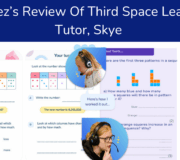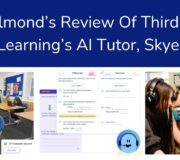7 Strategies To Drive Attendance And Engagement In Secondary Tutoring
In this blog, we’ve dug into the research and drawn on the expertise of the schools we work with as AI maths tutoring providers. We’ve listed seven strategies to overcome the barriers to intervention attendance and to drive engagement in secondary tutoring sessions.
Student attendance is the most fundamental requirement for students and schools to close the attainment gap. It is the first rung on the ladder of opportunity – students can’t catch up if they don’t show up.
Attendance at secondary
As tutoring becomes embedded as a permanent fixture in UK schools, interest has turned to the importance of intervention attendance. It is a particularly challenging issue for secondary schools, with estimates citing a 20 percent lower attendance rate to interventions compared with primary schools.
The reasons for this are numerous:
- lower school attendance rates at secondary (according to gov.uk);
- competing priorities during the school day;
- more complex timetables and scheduling issues;
- extra-curricular commitments.
And the list goes on…
So how can you boost student attendance? We’ve dug into the behavioural insights research and tapped into the experience and expertise of the hundreds of schools we provide AI maths tutoring to each week to share their insights to list 7 evidence-informed strategies to focus your resources on the strategies that work.
As AI tutoring providers, we’ve also seen a lower attendance rate from our secondary students than our primary. We worked with our schools to develop strategies which enabled us to dramatically improve secondary attendance. We’ve included our insights and the measures we have implemented for each strategy.
We are as invested as schools are in ensuring that, with budgets as tight as they are, all budget spent on interventions is allocated wisely and with the best chance of success.

Meet Skye, the voice-based AI tutor making maths success possible for every student.
Built by teachers and maths experts, Skye uses the same pedagogy, curriculum and lesson structure as our traditional tutoring.
But, with more flexibility and a lower cost, schools can scale online maths tutoring to support every student who needs it.
Watch Skye in actionWhy is attendance so important?
It is crucial that students are given every opportunity and the support they need to boost their attendance to intervention sessions. Research consistently shows a link between overall absences and poorer attainment at GCSEs. With one to one tutoring resulting in an additional 4 months’ progress at secondary, it’s important students are able to take full advantage of the opportunity.
Research into attendance, and more specifically, intervention attendance, is ongoing and growing due to exacerbated levels of absenteeism post-Covid.
In this blog, we’ve drawn on research and ideas that have been proven to work in specific contexts to help inform your own attendance plan, intended to be used in addition to your own knowledge of your students, their needs and the needs of your context.
As ever, research methodology varies and not all the research in this blog is through RCTs. We’ve also included reported successes from schools, repeatable processes and recommendations so we can give you a range of strategies to consider implementing in your own intervention plan.
Important links:
Education Endowment Foundation – Attendance interventions rapid evidence assessment
Gov.uk – Working together to improve school attendance
The Ultimate Guide to Maths Tutoring
A guide on how to choose, plan and fund the right tutoring approach for your students for maximum impact in your school.
Download Free Now!7 strategies to drive secondary student attendance
1. Prioritise relationships between tutors and their students
Positive relationships between tutors and students are more than a ‘nice to have’. They are foundational in creating the right learning environment where students feel supported, motivated and engaged.
Each and every tutor is an individual and will have their own strategies in their professional practice to engage and build relationships with their students, but the research can guide us.
What the research says
Consistency is key. It is important that regardless of whether it is an existing member of staff or an external provider, a qualified teacher or a teaching assistant, that wherever possible, the tutor remains the same. This ensures that the relationship is nurtured and given time to grow.
Designate time for relationship building. This can take place during the first session or before sessions begin, in addition to being integrated over the course of the intervention. Some may argue that this is wasting important intervention time but the positive impact of relationship building on attendance and engagement makes up for any ‘lost’ time.
Find similarities between tutors and students. The Education Endowment Foundation found that establishing common interests between tutors and their students through surveys resulted in higher attendance rates than tutors who used their usual strategies.
The survey, called ‘Snap Survey’, included topics such as:
- personal interests;
- hobbies;
- values.
In the study, the survey was an online form, but one of the participating tutoring organisations noted that it was important that tutors had autonomy to make the survey work for them, for example to deliver it using whiteboards.
How our community of schools build tutor relationships
Some schools have reservations about relationship building in the online context. But with the rapid adoption of technology and video conferencing to meet the needs of remote learning, most students have no problems connecting with Skye and building a positive learning environment.
A look inside Third Space Learning
Skye is designed to be a consistent presence, with pupils learning with it every week, or even more frequently, to support their progress. While traditional human tutors focus on building personal rapport, our AI tutoring model emphasises adaptive, dialogue-driven conversations to maximise engagement and learning impact. Skye’s pedagogical training, which is based on a decade of human tutoring data, guides it to apply essential tutor moves like increasing students motivation and relating learning to pupils’ interests. Our interactive, online diagnostic assessment not only identifies misconceptions and learning gaps to personalise students’ learning journeys, but also asks students about their hobbies and interests, enabling Skye to draw on this information in sessions.
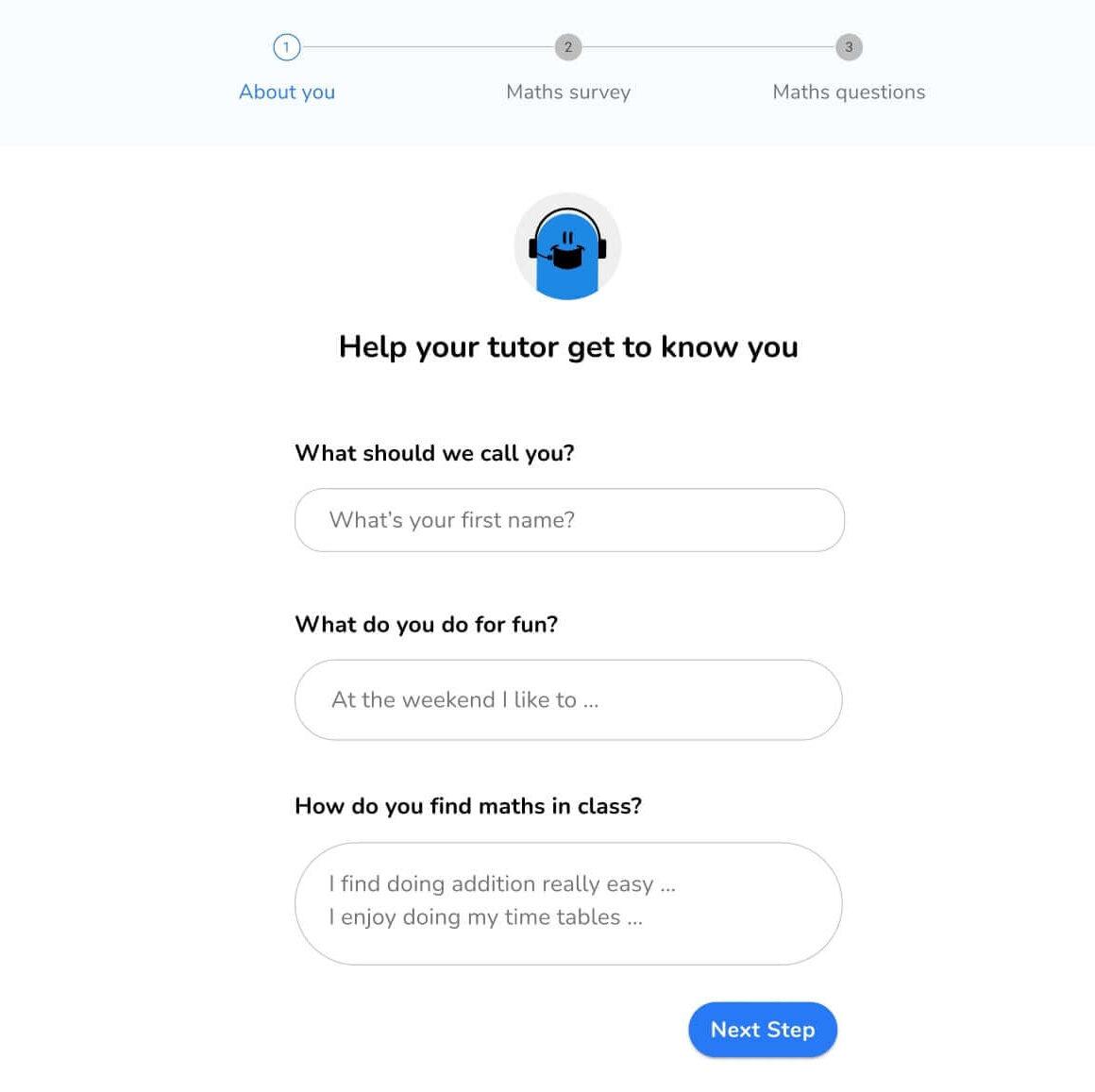
and their learning experiences to help tutors adapt sessions further.
They’re adapted to each key stage and pictured is a Year 7 survey.
2. Reminders to pupils
Life as a student is busy. They are balancing the pressures and requirements of school and homework with their home life and extra-curricular activities, all while navigating interpersonal relationships and developing themselves as individuals.
It’s not surprising that students sometimes forget about scheduled interventions, especially as secondary school is likely the first time they are expected to take responsibility for their own schedules, unlike primary school.
There are numerous strategies to help remind students, such as printing personalised timetables, using assemblies and form time to remind students or using technology to send alerts.
What the research says
Consider the communication method used to send reminders. In a study commissioned by the EEF, students received reminder email ‘nudges’ before their sessions. The results did not have a significant effect on intervention attendance. However, the open rate of messaging was only 26%, meaning many students did not even read the reminder emails.
In another study with apprentices and undergraduate students, researchers found SMS prompts to remind students about sessions and the support available to them had a significant impact on the number of students completing their programme. This might suggest it is important to reflect on the medium of messaging and reminders to make sure students see them in a timely manner.
How our community of schools build remind their pupils
Our schools use a range of strategies to remind students of their sessions, but above all it relies on collaboration between staff, parents and the students themselves. The majority of sessions take place after the school day, so getting parents involved to gain permission and support their child’s attendance is key!
A look inside Third Space Learning
We are in-school tutoring specialists and have designed our programme with schools in mind but we do not have access to pupil data, phone or email addresses. This means we cannot communicate directly with pupils but our sessions take place in the same scheduled time slot each week, with time slots available before, during and after the school day. Schools have flexibility to change these if needed. School holidays and half-term breaks are built into our programme to reduce the number of missed sessions.
Teachers are reminded of upcoming sessions 48 hours in advance and if students know they won’t be able to attend, teachers can contact our friendly customer service team who can cancel sessions and issue a credit to be used in the future.
3. Parental buy-in
As teachers, you will already be aware of the significant impact parental engagement can have on pupil outcomes. Research consistently shows that parental involvement has a positive impact not only on academic achievement, but also attendance, behaviour and children’s social and emotional development.
Getting parental buy-in for interventions will significantly improve attendance so it’s important that parents are involved from the get-go. Communicate the benefits of tutoring, make information about the location and timings of sessions readily available and share the expectations of students clearly. During the course of the intervention, celebrate children’s progress and communicate their achievements.
Utilise the existing range of communication forms your school already uses, such as:
- Letters
- Emails
- SMS
- Video
You might also consider using certificates or hosting an open evening for parents to share student work and achievements at the end of term, highlighting the interventions in a positive light.
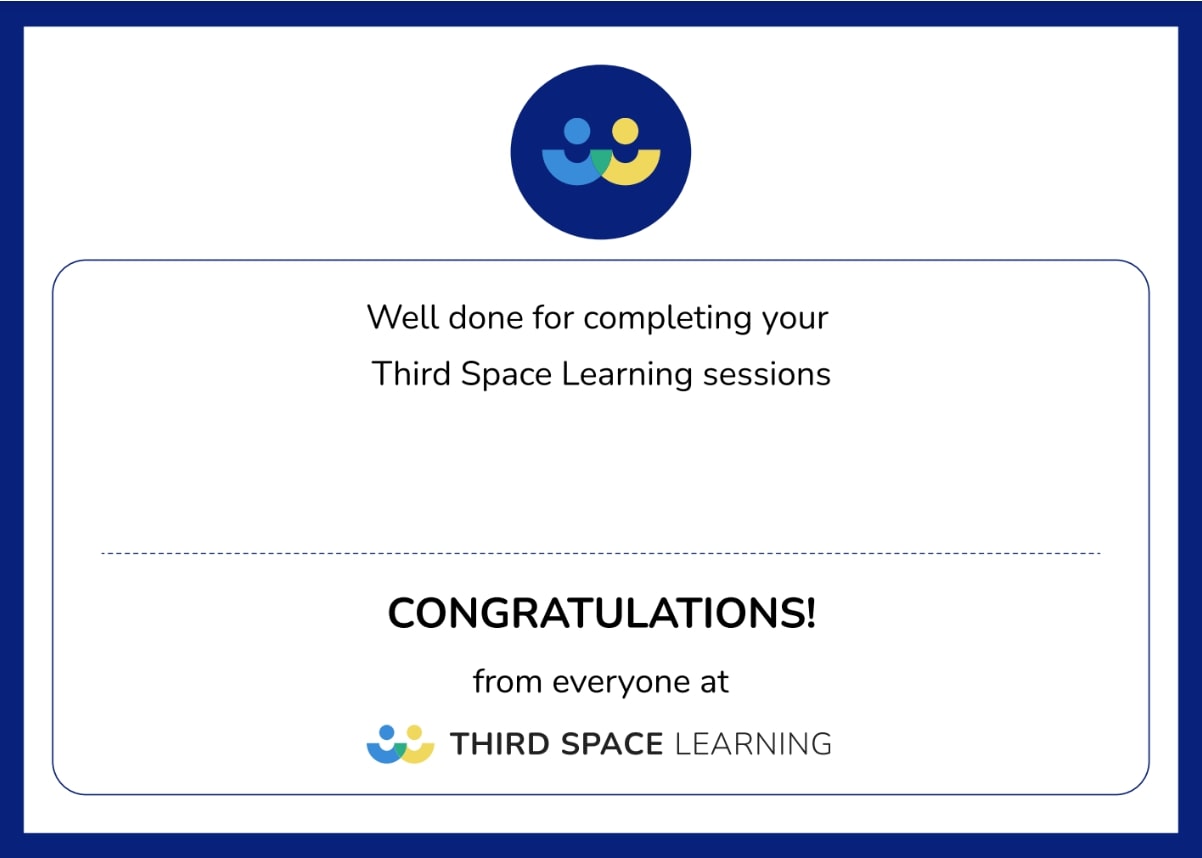
What the research says
SMS is an impactful and low-cost intervention to increase parental engagement in secondary schools. The EEF found that weekly texts over the academic year resulted in one month’s additional progress in maths, without any additional intervention or tutoring.
The nature of messaging is important. In the EEF’s study, more successful messaging at the secondary level related to children’s progress and upcoming events, such as tests. This suggests that weekly reminders about tutoring sessions and regular updates on progress would be gladly accepted by parents.
Listen, understand, empathise and support – but do not tolerate. This is the approach that Ofsted found the schools with the most successful strategies for attendance have. They have high expectations for student attendance and communicate these clearly, strongly and consistently to both parents and students. Student and parent concerns are addressed sensitively but effectively. You may consider creating an intervention-specific attendance policy or student engagement policy for clarity for all parties involved.
How our community of schools involve parents
We sent letters home for Y7 parents which clearly communicated how the school was paying for extra tuition at no cost to parents. Parent engagement was especially important for these students as it required parents to get students in school for the 8am session. The importance of this was passed from the very engaged parents to the students.
Headteacher, Glossop
A look inside Third Space Learning
At Third Space Learning, we know the importance of communicating with parents. When schools sign up to Third Space Learning, we provide letter templates that schools can use to communicate all the important information parents need to know, including how the tutoring works, safeguarding and how we support children’s individual needs.
We also make it easy for teachers to communicate student progress to parents by providing easy to access, on-demand, printable student reports.
4. Tutoring: a privilege not a punishment
Not only do we need to get the parents on side, we need to get students invested in their tutoring, too! Schools and teachers need to frame tutoring in a positive way and use language that counteracts the stigma that is sometimes attached to tutoring.
What the research says
Reframe the language we use to talk about interventions and position it as a privilege, not a punishment. Behavioural insight research consistently recognises the importance of positive reinforcement and language. The theory is evident in behaviour management strategies used in schools across the country, including Paul Dix. For example, students can be ‘selected’ or ‘invited’ to attend interventions and it is a privilege that can be revoked in the event of non-attendance or non-engagement.
Reduce the stigma attached to tutoring. The EEF found that tutoring in groups may reduce the sense of stigma, but it is important to reflect on the size and efficacy of group tutoring over one to one tutoring to ensure students are still able to make progress.
How our community communicates this
“We invite a large group of Year 11 pupils to take part, and then the students have to opt in on a first come, first served basis with the knowledge that if they don’t attend, they will be removed. Pupils (especially the boys) have wanted to take part so they can use the gaming headsets.” Headteacher, Lancashire
A look inside Third Space Learning
The Third Space Learning model means schools can benefit from reduced stigma while maintaining the benefits and personalised nature of one to one tutoring. We can tutor 10-20 pupils at a time in the same location so it’s an efficient use of resources.
Our sessions take place online using our online interactive classroom and a specially made leading gaming headset (which we provide for free) which helps students to connect with their AI tutor, Skye, to ask questions and address misconceptions in a safe learning environment.
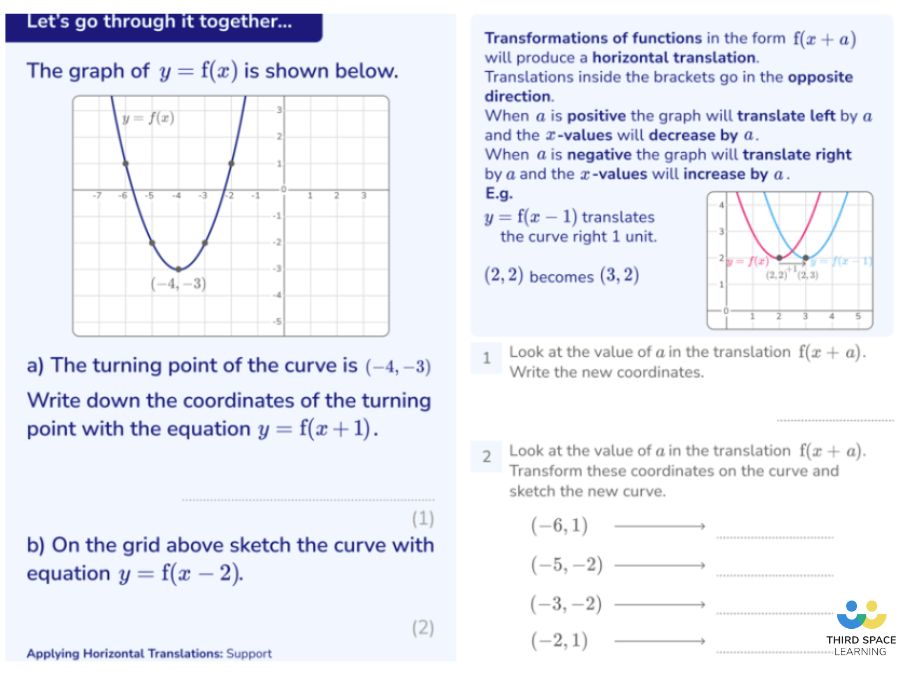
Read more:
5. Empower students
We often focus on engagement as making sessions ‘fun’, but at the secondary level we can create engagement through student empowerment.
Design interventions, assessments and reports to foster learner independence to bolster motivation and develop metacognitive skills that will benefit students far beyond the classroom.
Discuss students’ learning goals and make a collaborative plan to reach them, whether it’s to pass an exam to enter the course they want to study at college or to understand a specific topic in depth.
What the research says
Empower students from the outset. The EEF found that the most successful tuition is aligned with the curriculum and makes use of diagnostic assessment. Engage students in dialogue about the benefits of diagnostic assessment and involve them in their learning journeys. Explain that these initial assessments function not to test them, but to:
- Identify areas of strength (i.e. topics that they won’t need to cover in depth again!);
- Identify gaps to make sure their sessions are personalised to their needs;
- Identify misconceptions to ensure they can continue progressing;
- Keep track of their progress and celebrate successes.
How our community empower students through tutoring
Y11 pupils are told they have been carefully selected to take part and that they have been entrusted with the responsibility of attending.
Headteacher, Surrey
We had three year 11 students who were at risk of failing their exams, but wanted to do certain courses at college that require a pass. They themselves approached the school and requested extra help, and Third Space Learning is what the school provided. The pupils are very motivated because of this.
Headteacher, Leicestershire
A look inside Third Space Learning
Our programme is designed for personalised learning. Before students begin their sessions, they complete a diagnostic assessment that not only identifies learning gaps, but also misconceptions.
After each session, students are required to complete post-session questions which keeps record of student progress and informs their subsequent lessons. This means no time is wasted and students are always working towards plugging gaps in their learning.
Reports are available on-demand to teachers and these can be shared with students to celebrate their successes, start a dialogue about their learning and understand their progress. During the sessions, Skye uses a range of strategies and platform features to motivate students and give feedback on their progress, including verbal praise and on-screen rewards.
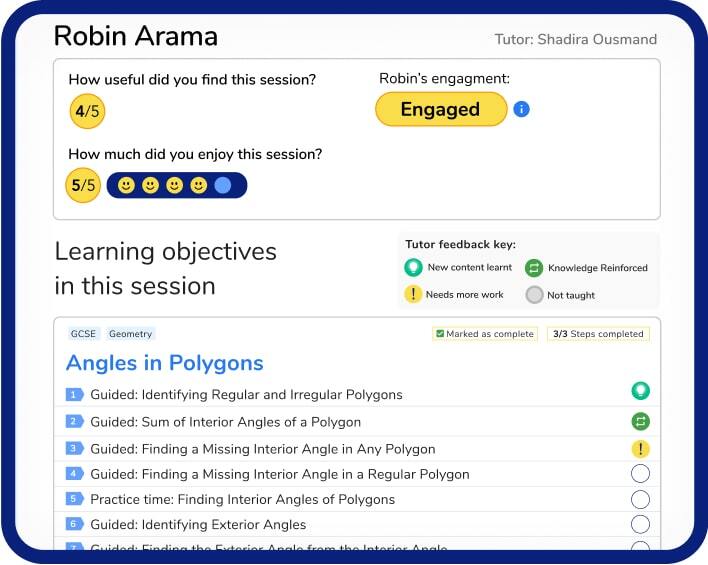
6. Appoint a tutoring rep in school
All of the strategies above beg the same question: whose responsibility is this? Is it the tutors themselves, the school or classroom teachers?
All staff in school have a responsibility to promote the benefits of tutoring and champion it to their students, however it might be beneficial to appoint a tutoring rep in your school. This should be a staff member with visibility and influence, who can communicate the benefits of tutoring in assemblies, around school and in lessons. Through this, tutoring will be embedded into your school’s offering, rather than an extra add-on.
The tutoring rep can also act as a personal tutor for students, someone they can trust outside of their tutor to go to for further information about tutoring and to discuss any issues or concerns. They should also follow up on unauthorised absences and work in collaboration with tutors and students to understand barriers to attendance.
What the research says
Research has shown a strong positive link between attendance at secondary schools and the role of a form tutor. Appointing a tutoring rep in school will mirror this relationship and support students during their tutoring sessions whilst improving the image of tutoring and removing any potential stigma.
How our community uses tutoring reps
Our Year 10 and 11 students had a scheduled chat with the Maths Head of Department who took them through why Third Space Learning was important and a privilege and why they should try their best.
Headteacher, Durham
7. Select the right kind of tutoring for student needs
This is the most important strategy. Regardless of the sanctions, rewards or promotional efforts around school, if the intervention is not the correct format or level for the student, they will not attend.
The first question you need to ask of a student is what kind of intervention is needed – attainment, behaviour or social and mental health-focussed?
You will then need to decide the best format for your students. There are three core choices you will need to make:
- Group size: one to one or small group?
- Delivery method: online or in-person?
- Type of tuition: internal or external provider?
Your decisions will need to draw on your knowledge of your context, the resources and funding available to you and the individual needs of your students.
Additionally, you will need to consider the external barriers to attendance and seek to support these, for example if the intervention will take place before or after the school day, if students will be missing the same subject lesson every week, etc. The National Tutoring Programme expects schools to organise tutoring at an appropriate time for students so as to encourage high attendance, but no further guidance is provided as it is highly context dependent.
What the research says
Ensure content is aligned with curriculum, assessment and student needs. The EEF found that tuition is most likely to be effective when it is targeted at students’ specific needs. This will require ongoing diagnostic assessment. This can be tricker in group tutoring, where you will have a range of different learning gaps and misconceptions within a small group of students.
If you do have a group of students with similar needs, group tutoring may be a good option. However, the EEF found that a general rule is the smaller the group, the better. When groups increase over five or six students, there is a significant decrease in effectiveness.
Evaluate the effectiveness of tutoring and be prepared to make changes. There are likely to be challenges that arise when implementing tutoring for the first time so it is important to continually monitor its effectiveness. If students are not attending, you may need to change the format or approach of sessions or change the location and time.
Sandra Hayes from Ofsted remarked that the best schools use ongoing assessment and attendance data to see progress in tutoring and use this information to prioritise between students and flexibly swap in and out students to maximise the impact on student outcomes.
How our community selects the right kind of tutoring for their students
Our community of schools use a range of different tutoring approaches in addition to Third Space Learning. This means the right tutoring approach can be paired with the student and their specific needs.
For example, one school divided their cohort; one half of the students used an online intervention programme and the other half had AI tutoring with Skye. After a term, the students switched. The school measured each student’s progress during each intervention period and used the data to select the best intervention for each individual students’ needs going forward.
A look inside Third Space Learning
Third Space Learning has spent the last decade working with hundreds of schools across the country and recognise the challenges schools face. We’ve built flexibility into our programme and teachers are able to flexibly change time-slots, cancel and reschedule sessions online or with the support of our friendly customer service team.
We also provide attendance information, simplifying attendance monitoring for teachers. Teachers can easily swap out students to ensure tutoring and funding is going to the students who will benefit most.
Conclusion
It’s critical that student attendance is considered in your intervention plan to make the most impact on student outcomes. Monitor levels of attendance and keep an attendance record, try different strategies and be prepared to make changes if necessary. This will result in good attendance levels to your interventions and happier, more engaged and motivated students who are ready to learn.
DO YOU HAVE STUDENTS WHO NEED MORE SUPPORT IN MATHS?
Skye – our AI maths tutor built by teachers – gives students personalised one-to-one lessons that address learning gaps and build confidence.
Since 2013 we’ve taught over 2 million hours of maths lessons to more than 170,000 students to help them become fluent, able mathematicians.
Explore our AI maths tutoring or find out about one to one tuition for your school.






